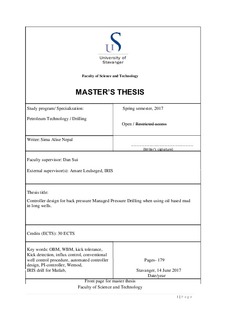| dc.description.abstract | In all drilling operations, downhole pressure requires to be closely monitored and measured at all times. Mainly, drilling fluid is used to balance the formation pressure downhole, a pressure that is created so that formation fluids are contained. In case, where the drilling fluid is excessively high or low, fracture or collapse may take place. In order to design the Mud Weight (MW) of the drilling fluid properly, the knowledge of annular pressure is extremely necessary. It must be inside a certain limit in order to avoid severe damage or harm to personnel, the environment and to the rig itself.
One of the methods, to precisely control the downhole pressure, is with Managed Pressure Drilling (MPD). In this operation, the mud system is closed by using a choke along with back-pressure pump to properly manage circulation process, an important technique when influx is seen in the well.
The main objective of this paper is to improve the ability to control pressure precisely in back-pressure MPD operation. The simulation takes its basis on long wells with Water Based Mud (WBM) and Oil Based Mud (OBM). A moderate gas kick is also initiated and circulated out with OBM and WBM for manual and automated operation. Automated operation is based on one of the most common control systems, namely Proportional, Integrate (PI) controller.
Methodology used in this research is based on IRIS flow model, along with a configuration tool provided by IRIS drill for Matlab called Wemod. Configuration uses details about the well, the fluid and specification of geo-pressure and temperature properties. Matlab is further used to reproduction of pressure relations.
By comparisons of mud systems OBM is more preferable in High Pressure and High Temperature (HPHT) wells, mainly due to the poor performance of water in WBM. However, in case of normal pressure and temperature conditions, OBM is associated with more environmental concerns and greater cost and therefore, WBM is preferred.
In simulation of moderate kick, in manual operation, the total time of influx was almost double that of automated operation. Thus, proving that automated operation has ability to handle a greater influx size, and be able to perform circulation by only using half of the time of manual operation. While comparing kick size with different fluid types, OBM with greater Oil Water Ratio (OWR), different stresses and different gel strength, underestimates a large part of the influx size. Circulation still takes equal amount of time for both fluid types, even when the influx is much greater for WBM. | nb_NO |

